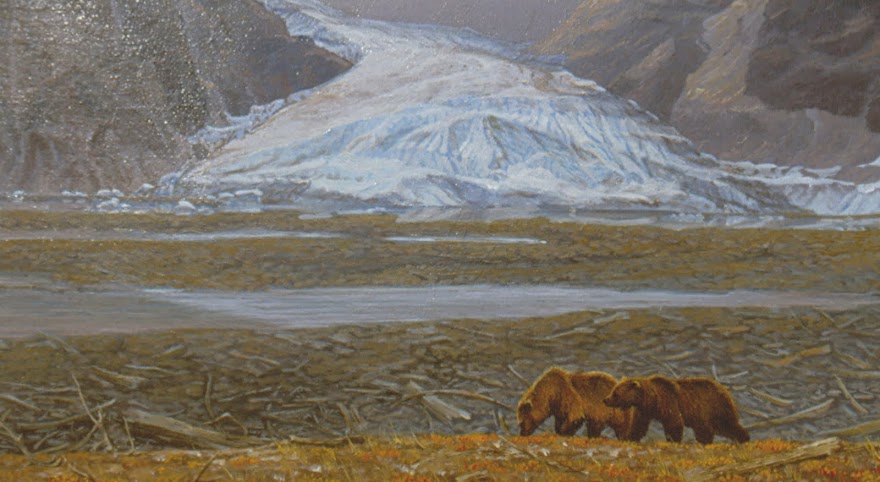Mendeltna Creek is about 140 miles northeast of Anchorage. It is on the opposite side of the Chugach Mountain range. That means we had to drive through some incredible scenery to get there. That is not the creek in the photo above. Mendeltna Creek is out on the more level terrain, (relatively speaking) of Alaska's vast Boreal Forest.
The long journey to the creek is far more picturesque than the creek itself.
One of the highlights of the journey is the rapidly receding Matanuska Glacier. This is the source of the Matanuska River, which is one of the dominate rivers in the whole region.
This is a view of the glacier winding up into the mountains.
I had to under-expose much of the foreground in order to keep the background from getting washed out. Nevertheless, scenery like this is why I choose to live in Alaska.
Another glacier at the bottom of a valley. This photo helps show vastness of the wild countryside. I doubt that anyone ever treks across these slopes.
Finally we descended out of the mountains and into the forest. These trees are Black Spruce. They burn very easily. Every Summer, there are gigantic wildfires in the Alaska bush that burn millions of acres at a time.
At last we reached the creek. I was invited on this trip by my nephew's old boss, Mark Hill. His energetic dog Q, accompanied us. He kept leaping out of the canoe and chasing around like a madman. We eventually had to tie a rope around his neck, attached to each side of the canoe so he could not leap out one side or the other.
Q was not happy being constrained to stay in the canoe.
We ascended the creek, trying to reach Old Man Lake. The current was too strong to paddle, so Mark put on chest waders and pulled the canoe, while I poled from behind. It was tiring work.
We encountered many obstacles that required the use of hatchet and saw to clear an opening for the canoe.
There were Moose along the way, and Caribou next to the creek. Too bad this fine bull Caribou would not show his face.
There was a 24 hour chorus of bird song. Exuberant Robins, White-crowned Sparrows, Alder Flycatchers, Swainson's and Hermit Thrushes, Ruby-crowned Kinglets, Boreal Chickadees, many warblers, and one Western Wood Pewee. Many calls I could not identify.
It's light all night long nowadays, and the birds never quit calling. The predominate sparrow of the place was Savannah Sparrow. I kept hoping to get a Song Sparrow, which is hard to find in most of Alaska. The notched tail of the sparrow above, identifies it as a Savannah Sparrow.
Such a cooperative subject deserves a second photo.
After fighting the current for 7 hours, we ran out of steam. We were not even halfway to the lake. So we camped on thick carpets of moss beside the creek. My little tent was quite comfortable, but sleeping on the ground is hard on these old bones. My biggest complaint is that there were not enough mosquitos. (joke) Even with repeated applications of repellent, I came home with at least 50 itchy bites.
In the morning we easily paddled back down the stream. I was in front, while Mark took the stern. It took about an hour of pleasant paddling to get back down.
We spooked up a pair of Great Horned Owls. Only the female allowed me to get a photo. The male sat quietly in the open, but took off before I could get it in the viewfinder.
Back where we parked the car we were greeted by this Snowshoe Hare. Mark worried about losing his keys in the water, so he buried them under a chunk of concrete near the car.
When we returned, the concrete had been moved aside, and the keys were nowhere to be found. A Red Squirrel mocked us from a tree, and some Gray Jays came to enjoy our frustration. We know one of these curious creatures made off with the keys. My money is on the squirrel. Mark called his wife who had to drive out from Anchorage with a spare key.
We had a long wait, and I watched birds and photographed wildflowers to kill the time. There are already too many photos on this blog post so those photos will have to wait for some future time.
